This Post May Contain Affiliate Links
In compliance with the FTC guidelines, please assume that some of the links on these posts and sites are affiliate links (Amazon or others) from which I may earn a small compensation/commission from sales of certain items at no extra cost to you from qualifying purchases.
Anytime you see a link that looks like “astore.com, paid link, #ad, #CommissionsEarned or Amazon/Amazon.com/ca,”… it can be assumed that it is an affiliate link.
To learn more, follow the link below.
Concepts To Improve Guitar Playing
Getting your playing to a pro-level requires patience, perseverance and attention to several factors.
There is a lot of information on the web on how to play guitar, with different techniques and a plethora of courses and exercises.
Still, this article is more directed to an Overall approach and a Real-world mindset that keeps me growing, at my best, and maintenance of a consistent level of skill.
Improving on these 10 Veteran Concepts will give you the 20% to get you through 80% of your situations.
First Electric Guitar
Many say that the birth of the electric guitar started with a Jazz guitarist named Charlie Christian (1916-1942) when he added a pickup to his acoustic around 1936 with the desire to play guitar solos and have them heard over the backing music.
Young & Ever Changing
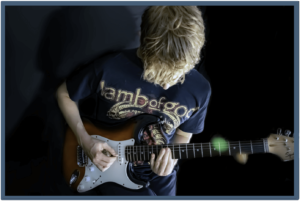
The electric guitar is evolving, and players are pushing boundaries with concepts and techniques and not many formal standards like in traditional string instruments, i.e. the violin, viola and cello, first built in the early 16th century in Italy.
But some concepts carry over.
1) The Circle Of 5ths
This musical theory concept organizes 12 Keys in a sequence of Perfect 5ths to understand key signatures and diatonic chords in those key signatures.
Why Is A Perfect 5th Called Perfect?
Perfect 5th is a term used to identify intervals, and because of their pitch relationship and degree of consonance, they group these into perfect intervals along with perfect 4ths and Octaves.
This perfect 5th found in the key signature or Scale is also known as the dominant interval. It is the first harmonic and most important interval outside the octave and is spelled in the roman numeral V.
History Of The Circle Of 5ths
Developed in the late 1600s to early 1700s, the first diagram appeared in the Grammatika (1679) of the Russian composer and theorist Nikolay Diletsky as a tool to present music theory for composition.
It was the “First of its kind.”
(See Image)
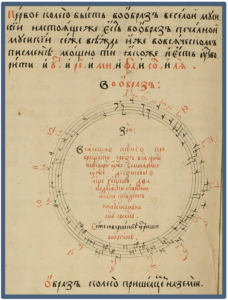
Circle of fifths featured in the 1679 version of Nikolay Diletsky’s “Idea grammatiki musikiyskoy.”-image courtesy of Wikimedia and is licensed under the public domain.
Followed by the German composer and theorist Johann David Heinichen (1711) created the Circle of 5ths diagram, called the “Musical Circle.” published in 1728.
With others attempting to improve on the concept David Kellner (1737) proposed to have the Major keys on one Outer Circle and the Relative Minor Keys on a Second Inner Circle, which is still used today, resembling an Analog Musical Clock.
A Musical Analog Clock
The keys are structured so each key is a 5th apart from the previous one, with C being at the noon position and G flat/F sharp being at the 6:00 position, moving in intervals of 5ths clockwise or 4ths counterclockwise, commonly referred to as the Circle of 4ths. (See image)

The Circle of 5ths – Image courtesy of Wikimedia and licensed under the Creative Commons Attribution-Share Alike 3.0 Unported
Why Is This Good For Guitarists?
This is a valuable concept and tool for players to familiarize and visualize themselves with the 12 musical key signatures.
The chart presents all the diatonic major and minor keys based on the number of sharps or flats in each signature from a structured order, indicating how the different keys relate to each other and how chords fit together within a basic Diatonic Key Signature.
Diatonic Key Signatures
The term Diatonic refers to the 7 scale degrees forming an octave without altering a key.
Each of the 12 keys in the Circle of 5ths serves as a Root key to its Major or Relative Minor, and each of these keys will have Diatonic Scales and chords associated with those keys.
What Is A Relative Minor?
The Relative minor is the VI tone in the key.
So in the Key of C, the relative minor would be A minor.
On the Circle of 5ths chart, the Major key is usually indicated by a Capital letter and the minor key by a Lowercase.
(See image)
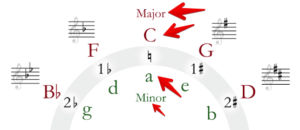
Image with how the Circle Of 5ths displays Major & Relative minor keys
Because the Major and minor keys have the same key signature, it is referred to as relative minor to one another.
How Guitarist Use The Circle of 5ths
2) Scales & Modes
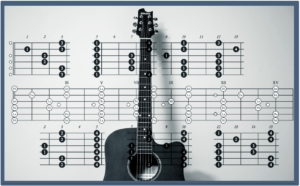
A Scale for Guitarist is a sequence of notes in intervals to be played, ascending or descending in patterns.
What Are Modes
Modes are essentially “Scales within a Scale.”
So if your Parent Key is C and you play a C Scale from its 2nd note ‘D” you get a different sound or Mode; in this case, the resulting sound would be Dorian.
This can be done with every note in the Scale.
Modes In The Major Diatonic Key
- C= Ionian
- d = Dorian
- e = Phyrigian
- F = Lydian
- G = Mixolydian
- a = Aeolian or Relative Minor
- B = Locrian
Why Is This Good For A Guitarist?
Learning Scales and Modes help in ALL areas of guitar playing, from sonic expression, fingerboard note mastery, ear training, finger strength, speed and dexterity.
Once you understand your fingerboard using scales and modes, you can play Horizontally over any chord in the Diatonic Key.
Horizontal Playing
This is a term used when you are soloing but when you do NOT care about the Chord changes other than making it sound good with the notes you are playing.
Added Tips
Intervals Are Always In Reference To The Major Scale
So the Blues Note in the Minor Pentatonic would be referenced as the flatted 5th of the relative Major Scale (i.e. in A minor Pentatonic, that would be E flat or the flatted 5th of the C Major scale)
Learn The Characteristics Of Each Scale You Play
i.e., the Harmonic Minor has the #7 know-how that sounds & works in your solos over what chords.
3) Arpeggios/Chord Tone Targeting
Arpeggios on guitar are when the notes of a chord are played individually, one after the other.
Arpeggios provide a framework for targeting chord tones and can be used to add colour to guitar solos and fills.

What Is Chord Tone Targeting?
This is where you look at the progression you are playing over and emphasize notes from the Chords Arpeggios.
A really powerful tool as opposed to just playing horizontally in the key of the Chords.
Why?
The chord tones or notes from the Arpeggio are the best-sounding notes to play per chord.
Chord tone soloing is a technique to make your solo sound “in” with the backing track. With this technique, you can choose the notes that will sound best at any moment in your solo.
Modern-day players sometimes apply Two-Handed tapping and Sweep Picking to the Arpeggio playing process.
Industry pros like Marty Friedman explain…
“Pay attention to the chords and follow the chords.
This makes your solos sound like they are worked out, even if you improvise off your head.
It is the goal of every guitar player to be able to solo melodically against a chord progression that is only in your head without any guitar or other guitar players playing behind you outlining those chords, and the listener should be able to hear those same chords in your solos without the rhythm player behind playing those chords.
The more you know what is happening behind you, the more effective your solos will be, and you will never feel lost.
Therefore you can be effective in a 3-piece band with just a bass player.
This is a guitar player’s secret weapon if they choose to use it.”
When To Apply The Horizontal Or Chord Tone Approach
Generally, there are no rules, just a preference of what you think sounds best. Usually, it’s a combination of both at the same time.
Play horizontal if…
The chords are constantly changing, or sometimes the changes happen so quickly that not to bother playing over them.
Also…
Use chord tones if just playing horizontally can come off as sounding stale.
But the concept here is always to know what the chords are in the background and where you are in relation to the key; never get lost, and mix both concepts.
4) Navigating The Fingerboard
This concept is about learning the notes across the entire fretboard in key to navigate where you get and want certain tones and fully understand why concepts like scales, arpeggios, riffs, soloing and chords work together and others do not.
But to do this, you must learn to break off patterns and shapes.
This concept of breaking out of the scale patterns and how Al Di Meola approaches this.
“How I break the habit of playing in scale positions, the exercise is playing on 1 string at a time.
So playing over a G minor chord on the high E string only, I would play as melodically as possible in the minor scale and only on the one string.
Learn the whole neck and play on the whole neck; this will get you out of the habit of playing in positions.
Also, do this on all of the strings.
There is a lot you can do just playing on one string.”

5) Ear Training
This is something that is not discussed but is vital as a player.
Developing your ear allows you to hear note choices with more depth and takes your playing to another level.
Your ability to identify subtleties like…
- Notes & Scales
- Chords/Progressions, Rythms& Accents
Should be at the top of your musical priorities, for a masterful ear is the key to the musical expression on the guitar.
Yngwie Malmsteen on ear training…
“When people ask me for advice, I respond by saying…Play with your ears.
When it sounds good, it’s good.
I wasn’t thinking about what I was doing, but I knew what I wanted to hear, and I would work very hard until I got to what I wanted.”
6) Right-Hand Techniques

Working your left hand is a non-starter when it comes to playing electric guitar techniques, but what is also important is the training of the Right Hand, and working it is equally as important as the left.
This concept is essential for…
Hand Synchronization
This is when both hands have the ability to fret and pick together synchronized, resulting in clean, articulate notes.
7) Hand Stretching
This concept is that warming up the muscles and ligaments improves blood flow in your hands by gradually elongating muscles through stretching and improving…
- flexibility,
- endurance &
- dexterity
so that you can enjoy playing the guitar and avoid unnecessary pain and injury.
Watch Video On Hand Stretching
8) Using A Metronome
The Metronome is a tool that ensures your playing stays in sync by giving a constant sound-based click with varied tempos.
This tool reinforces your…
- Inner timing mechanism to prevent “Rush or Drag” in playing live or in recordings &
- Builds control over your speed & slower playing or rhythmic and technical playing.
9) Free Soloing
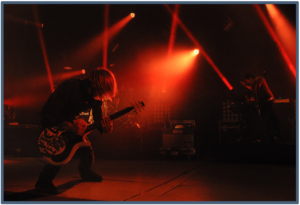
Free soloing is a great exercise to tie in all the concepts you are working on.
- Different picking exercises (Sweep, Alternate, Tapping etc.)
- Different Scales, Arpeggios, Horizontal & Chord Tone Targeting
- Hand synchronization & Fretboard Navigation
- Timing and Ear development etc.
So the concept here is to improvise over a music track and go until you make a mistake, then stop the track and practice that section you were trying to get across on the solo until you get it right, because your fingers wanted to accomplish something but could not get it down.
Then get back to improvising, and use that section as often as possible until you feel comfortable.
Steve Vai on mastering challenging finger passages…
“Always do an exercise out of anything you CAN NOT do; I did it when I started and still make this practice approach today.”
10) Consistency
Because the guitar is touch-sensitive, skills can deteriorate quickly, so having your fingers on the instrument ensures a skill set maintained at a level and provides constant growth, muscle memory, and musical discipline.
Final Thoughts
Improve Your Guitar Playing With These Concepts
I have been wanting to write this post for a while now but did not know how to approach it, and it will get updated from time to time. Still, I have faith it will provide you with some inside into the mindset of a guitarist from an overall approach, not just from the exercise perspective.
Like anything else, once you hit a level in your progress and playing, there is always more; this type of thing never really levels off, either moving forward or backward, rarely standing still; it is an incredible instrument but not very forgiving.
If you take these concepts and put them in your toolbox, your skills will grow, playing will sound more melodic, and you will feel in command of your instrument.
Did You Like This Article?
Check out the post on using a Guitar String Dampener.
Also…
Please leave your comments in the section below, and if you have a favourite player, guitar or topic you would like me to publish an article on, leave a note below.
As always, stay the course and keep playing.
Feature image courtesy of StockSnap from Pixabay
Young guitar player Image by Ri Butov from Pixabay
Scale and Chord chart Image by Barbara A Lane from Pixabay
Live performer Image by Kevin Phillips from Pixabay
Right-hand picking guitar Image by StockSnap from Pixabay
Live guitar player Image by Joanna D’Ancona from Pixabay
Al Di Meola playing live on acoustic image courtesy of Niki Dinov from Pixabay
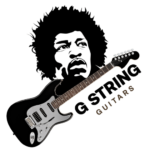
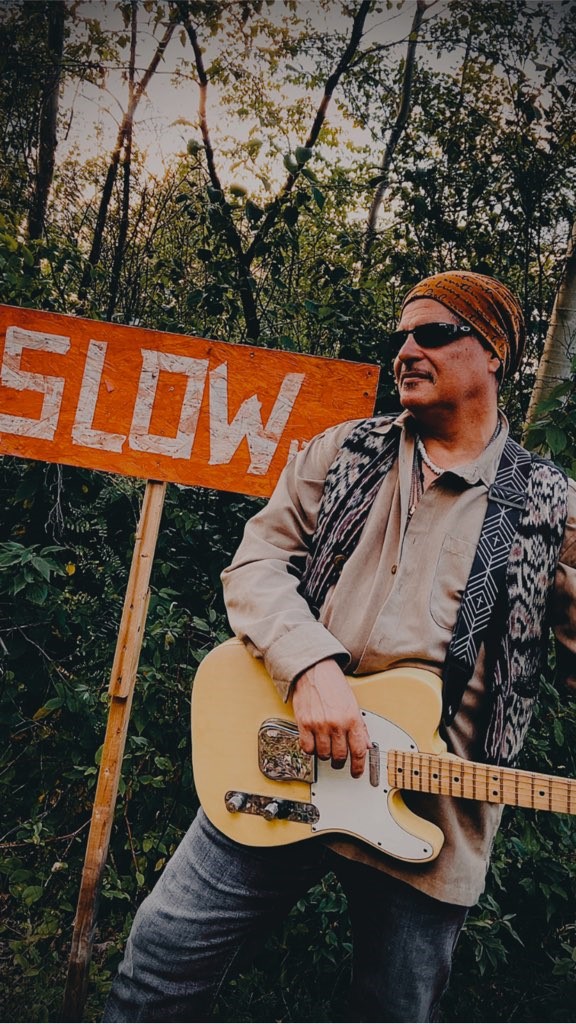
Starting A Journey At 7 Years Of Age, The Love For The Guitar Only Became Stronger Going Into My Teens. This Leading To An Exciting Time Of Teaching, Performing, And Recording. Join Me Now As We Can Bring The Love Of This Instrument To Other Musicians Globally.

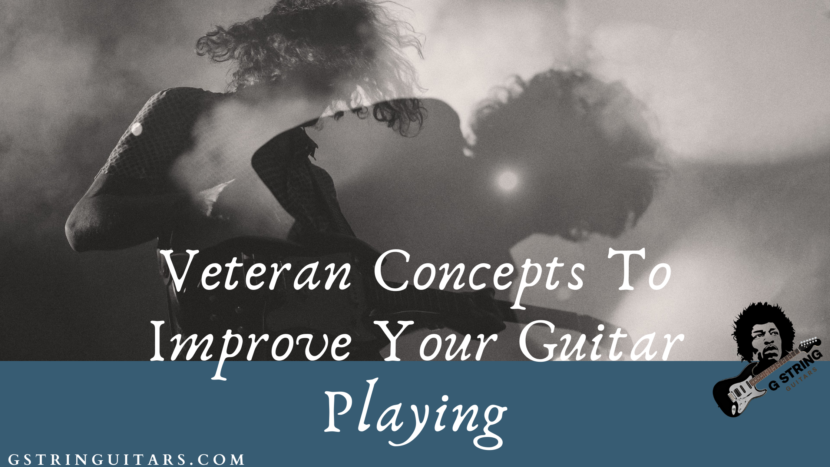




I just read the article on 10 veteran concepts to improve guitar playing and I must say, it was a really helpful and informative read. As a guitar player myself, I am always looking for ways to improve my skills and techniques, and the tips in this article are certainly worth trying out.
One concept that really stood out to me was the importance of practicing with a metronome. I have always found it challenging to keep a steady beat while playing, and the article’s suggestion to start with a slow tempo and gradually increase it as my skills improve is a great way to improve my timing.
I also appreciated the emphasis on the importance of listening to and learning from other musicians. As a beginner, it can be easy to get caught up in trying to play fast and show off, but the article’s reminder to focus on the music and the emotion behind it was a valuable reminder.
Overall, I think this article is a great resource for any guitar player looking to improve their skills and take their playing to the next level. Thanks for sharing!
Hello Lorenz
Great to meet you, and thank you for coming by the site and leaving your feedback.
This article has been sitting on my lap for a while.
It was something that I wanted to share, for it would be information that has benefited me in the process of playing and growing without too many plateaus, like the chord tone targeting and how Marty Friedman approaches this process, he is an incredibly melodic player, and I would recommend you check out some of the other posts on his guitars.
Working with a Metronome and using your ear are probably 2 of the most solid concepts in the space, and you will never go wrong with mastering them.
Also, it was my first post for this site, so I would like to get more into the theory area of guitar playing to share and learn from other players.
Let me know if you would like to do anything specific, and i will do my best to make that happen, also, do not hesitate to read more and let me know your thoughts.